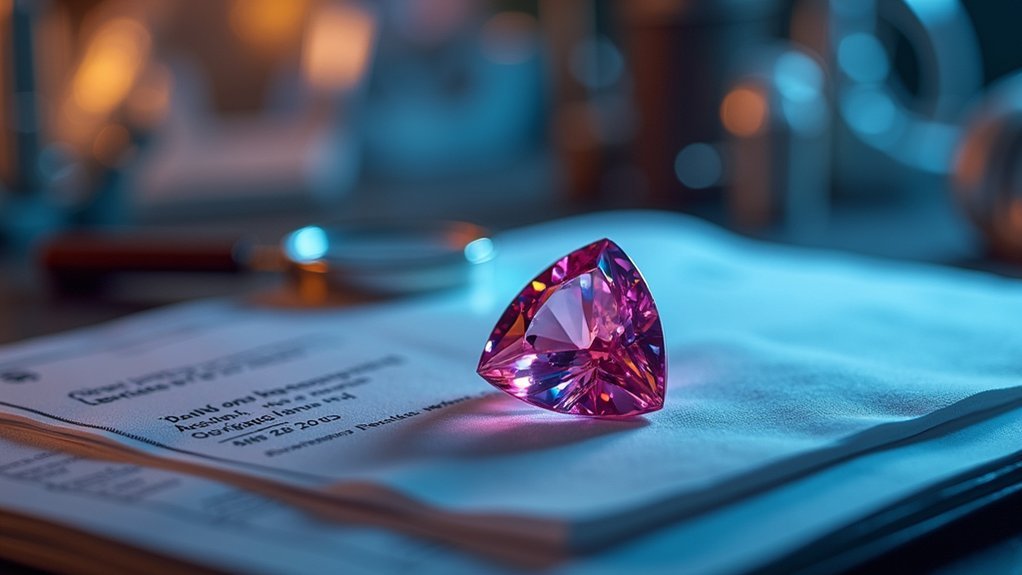You’ll gain immediate credibility and command 20-30% higher salaries when you earn professional certification in gemstone valuation. Certification validates your expertise in distinguishing natural from synthetic stones, mastering the Four Cs, and using advanced testing techniques like spectroscopic analysis. You’ll build trust with clients and insurance companies through documented authenticity, while accessing exclusive job opportunities and networking with industry professionals. This specialized knowledge positions you as a competitive expert in the growing jewelry market.
Understanding the Fundamentals of Gemstone Properties

Mastery of gemstone valuation begins with understanding the four fundamental properties that determine a stone’s worth: cut, color, clarity, and carat weight.
These elements form the foundation of gemstone quality assessment and directly impact market value.
You’ll evaluate cut quality by examining how effectively light reflects through the stone, enhancing its brilliance.
Color assessment requires analyzing hue, tone, and saturation—vivid colors typically command higher prices.
Clarity involves identifying inclusions and blemishes that affect transparency and beauty.
Carat weight measures size, with larger stones exponentially increasing in value due to rarity.
Professional gemstone certification validates authenticity and quality through systematic evaluation of these properties.
Understanding these fundamentals guarantees you can accurately assess gemstone properties and provide reliable valuations that meet industry standards.
Building Professional Credibility in the Jewelry Industry
While technical knowledge forms the backbone of gemstone evaluation, establishing professional credibility requires formal certification that validates your expertise in the jewelry industry.
When you’re a certified gemstone professional, clients immediately recognize your authority and trust your assessments. This gemological certification demonstrates you’ve mastered essential skills like distinguishing natural from synthetic stones and understanding quality and authenticity markers.
Your certification opens doors to higher-paying opportunities and attracts discerning clients who value expert guidance.
You’ll gain access to exclusive industry events, specialized resources, and networking opportunities with fellow certified professionals.
This credibility isn’t just about knowledge—it’s about positioning yourself as a trusted authority who upholds industry standards and maintains professional integrity throughout every valuation.
Mastering the Four Cs: Cut, Color, Clarity, and Carat Weight

Although gemstone evaluation involves numerous technical considerations, the Four Cs—Cut, Color, Clarity, and Carat weight—serve as your fundamental framework for determining a stone’s true value and market worth.
The Four Cs—Cut, Color, Clarity, and Carat weight—form the essential foundation for accurate gemstone valuation and assessment.
When you master cut evaluation, you’ll recognize how proper faceting enhances brilliance by up to 50%. Understanding color grading means distinguishing between D-grade colorless diamonds and premium rare hues like blue or pink.
Your clarity assessment skills will help you identify inclusions ranging from flawless specimens to visibly included stones. Carat weight determines size, but you’ll discover that value per carat increases exponentially when superior cut, color, and clarity combine.
These interconnected factors don’t work independently—you need thorough knowledge of all four criteria to accurately assess gemstone quality and provide reliable valuations that clients trust.
Identifying Natural vs. Synthetic vs. Treated Gemstones
Beyond evaluating the Four Cs, you must determine whether a gemstone is natural, synthetic, or treated—a distinction that fundamentally affects its authenticity and market value.
Natural gemstones form through geological processes over millions of years, while synthetic gemstones are laboratory-created using similar processes. Treated gemstones undergo enhancements like heat treatment or dyeing to improve their appearance.
Gemstone certification provides clear identification of each type, guaranteeing you’re well-informed about your purchase. The Gemological Institute of America uses advanced testing methods to accurately distinguish between natural and synthetic stones, enhancing certification credibility.
Understanding these differences is vital since they directly impact authenticity, quality, and market value. Proper certification guarantees transparency about treatments, protecting you from misrepresentation.
Learning Advanced Testing and Evaluation Techniques

You’ll master spectroscopic analysis methods to identify chemical compositions and detect treatments that aren’t visible through standard gemological testing.
Precision measurement tools become essential for accurately determining the 4Cs, as even slight variations in cut angles or color saturation dramatically affect market value.
Treatment detection protocols require systematic approaches using specialized equipment to distinguish between natural characteristics and artificial enhancements that impact pricing.
Spectroscopic Analysis Methods
When you’re evaluating gemstones for certification, spectroscopic analysis methods provide the most precise and reliable identification techniques available.
You’ll use infrared and UV-Vis spectroscopy to determine chemical composition and detect treatments that affect value. Raman spectroscopy gives you molecular fingerprints that distinguish natural from synthetic stones, vital for accurate gemstone certification.
Your refractometer measurements reveal refractive indices important for identifying gemstone qualities and determining authenticity.
Fluorescence spectroscopy helps you detect elements and inclusions that impact marketability.
When you master these advanced techniques, you’ll perform evaluations that meet the standards of any reputable gemological laboratory. The specialized training required for spectroscopic analysis enhances your certification accuracy and professional credibility, making you indispensable in gemstone valuation.
Precision Measurement Tools
Building on spectroscopic identification capabilities, precision measurement tools form the backbone of accurate gemstone evaluation and certification.
You’ll rely on digital calipers to measure exact dimensions, guaranteeing precise documentation of length, width, and depth. Gem scales become indispensable when accurately determining carat weight, as even minor variations considerably impact value assessments.
These precision measurement tools enable you to document gemstone characteristics with scientific accuracy. You can’t afford approximations when establishing market value or insurance coverage.
Digital calipers provide measurements to hundredths of millimeters, while certified gem scales deliver weight readings to three decimal places.
Certification guarantees your measurement techniques meet industry standards, building client confidence in your evaluations.
Mastering these fundamental tools establishes your credibility as a professional gemologist capable of delivering reliable, defensible appraisals that withstand scrutiny.
Treatment Detection Protocols
Since gemstone treatments can dramatically alter both appearance and value, mastering treatment detection protocols becomes essential for accurate certification.
You’ll learn advanced techniques like spectroscopy and microscopy to identify enhancements the gemstone may have undergone, including heat treatment and dyeing. Understanding refractive index measurements helps you differentiate between natural and treated stones by comparing expected values to actual readings.
Chemical analysis through energy-dispersive X-ray fluorescence (EDXRF) enables you to detect specific treatments by analyzing elemental composition.
You’ll become familiar with various treatments like laser drilling and fracture filling, applying appropriate detection methods effectively. This advanced training enhances your ability to provide accurate gemstone certificate documentation, ensuring gemstones authenticity verification that ultimately increases consumer confidence in your professional assessments.
Protecting Clients From Fraudulent Gemstone Sales

You’ll encounter sophisticated fraud schemes in gemstone sales that require advanced detection skills to protect your clients’ investments.
Your ability to identify synthetic stones, spot undisclosed treatments, and verify authenticity becomes essential when dealers attempt to misrepresent materials or inflate values.
These skills directly impact your clients’ financial security and your professional credibility as a certified gemstone evaluator.
Identifying Synthetic Stones
Three critical differences separate natural gemstones from their synthetic counterparts, and recognizing these distinctions can save you thousands of dollars in fraudulent purchases. Understanding these markers protects you from costly mistakes when synthetic stones are misrepresented as natural gems.
Certified gemstones undergo rigorous testing by reputable labs using advanced technology to verify authenticity. These detailed examinations identify treatments and enhancements, ensuring transparency about each stone’s true nature.
| Natural Gemstones | Synthetic Stones | Detection Method |
|---|---|---|
| Natural inclusions | Perfect clarity | Microscopic analysis |
| Irregular growth patterns | Uniform structure | Spectroscopic testing |
| Unique optical properties | Predictable characteristics | Advanced equipment |
Certification reports from recognized laboratories provide guarantees of authenticity, boosting your confidence while safeguarding against counterfeit gemstones flooding the market.
Detecting Undisclosed Treatments
Although gemstone treatments can enhance a stone’s appearance and durability, undisclosed modifications represent one of the most important threats to your investment security.
Certification from reputable laboratories like GIA and IGI provides vital protection against fraudulent gemstone sales by detecting hidden treatments that sellers mightn’t reveal.
You’ll discover that untreated rubies can command prices 10 to 100 times higher than their treated counterparts, making disclosure essential for accurate valuation.
Advanced testing methods used in certification processes identify common treatments like heat enhancement or oiling that greatly impact value.
Without proper documentation of treatments, you’re vulnerable to overpaying for modified gemstones sold as natural specimens.
Certification reports guarantee authenticity verification while establishing transparency and trust in your transactions.
Verifying Gemstone Authenticity
How can you protect yourself from purchasing synthetic diamonds masquerading as natural stones or lab-created emeralds sold as mined gems? Certification provides the definitive answer.
When you obtain gemstones certified by reputable laboratories like GIA and IGI, you’re guaranteed authentic gemstones backed by rigorous scientific examination.
These labs conduct detailed analysis of each stone’s characteristics, documenting type, quality, and any treatments applied. This thorough evaluation protects you from fraud and misrepresentation that’s unfortunately common in the gemstone market.
With certification in hand, you can make informed decisions about your purchases. You’ll know exactly what you’re buying, avoid costly mistakes, and guarantee your investment maintains enhanced resale value.
Expert verification eliminates guesswork and gives you confidence when maneuvering gemstone transactions.
Enhancing Career Opportunities in Gemology

When you pursue gemstone valuation certification, you’re positioning yourself for considerably better career prospects in the competitive gemology field. Employers actively seek candidates with recognized qualifications from a reputable gemological institute, giving you access to exclusive opportunities in high-end jewelry stores, auction houses, and trading companies.
| Career Benefits | Financial Impact |
|---|---|
| Access to exclusive job openings | 20-30% higher salaries |
| Increased client trust | Better business opportunities |
| Industry relevance | Competitive market advantage |
Your certification demonstrates expertise in evaluating certified gemstones and determining accurate gemstones value, enabling clients to make an informed purchase. You’ll stay current with industry standards through continuing education, making you more sought-after as the market evolves and ensuring long-term career success.
Developing Expertise in Market Pricing and Valuation
You’ll master market price fundamentals by understanding how the 4Cs directly impact gemstone values and learning to interpret certification data from laboratories like GIA and IGI.
Your valuation methodology must account for origin premiums, with stones from prestigious locations like Mogok Valley commanding exponentially higher prices than their treated counterparts.
You can’t effectively price gems without tracking current market trends and recognizing emerging opportunities in high-value specimens like Paraíba tourmaline.
Market Price Fundamentals
Professional gemstone valuation hinges on mastering the intricate relationship between quality factors and market dynamics that drive pricing decisions.
You’ll need thorough understanding of the 4Cs—cut, color, clarity, and carat weight—as these fundamentals directly determine market value.
Gemstone origin greatly impacts pricing; Burma rubies command premium prices compared to stones from other sources.
Market demand creates surprising valuations, with semi-precious Paraíba tourmaline reaching $20,000 per carat.
Certification from reputable laboratories enhances pricing by providing documented authenticity that buyers trust.
You must stay current with market trends and treatment disclosures, as these factors dramatically affect valuation accuracy.
Understanding these market price fundamentals through proper certification guarantees you can navigate the complex gemstone marketplace with confidence and expertise.
Valuation Methodology Mastery
Although mastering gemstone valuation requires years of dedicated study, you can develop systematic expertise by following proven methodological frameworks that professional appraisers use daily.
You’ll need to master the 4Cs—Carat, Cut, Color, and Clarity—which form the foundation of diamond certification and valuation across all gemstones. Understanding origin and treatment history becomes vital when determining market value, especially for premium stones like rubies and emeralds.
You must analyze recent sales data and pricing trends to stay current with market fluctuations. Familiarizing yourself with grading standards from laboratories like GIA and AGS guarantees accurate quality assessment.
Finally, you’ll develop expertise by studying supply and demand dynamics, including rarity factors that greatly influence valuation outcomes in various market conditions.
Understanding Legal Requirements for Professional Appraisers
When entering the field of gemstone appraisal, you’ll need to navigate a complex web of legal requirements that vary considerably across different jurisdictions.
Professional appraisers must adhere to specific legal standards to guarantee their valuations are recognized and respected in the marketplace. Most regions require appraisers to obtain certifications through accredited training programs and examinations that demonstrate expertise.
Key legal requirements include:
- Obtaining proper licenses or certifications specific to your jurisdiction
- Complying with Uniform Standards of Professional Appraisal Practice (USPAP)
- Disclosing any conflicts of interest to clients
- Providing written reports following legal and professional guidelines
- Maintaining liability insurance for protection against claims
Meeting these requirements builds credibility and guarantees your gemstone appraisals meet professional standards while protecting both you and your clients.
Gaining Access to Industry-Standard Equipment and Tools
Beyond meeting legal standards, certification opens doors to sophisticated equipment that separates amateur enthusiasts from professional valuators.
You’ll gain access to industry-standard equipment including refractometers, spectroscopes, and microscopes that enable precise analysis of gemstone properties like clarity and color. This equipment guarantees accuracy when grading stones according to established criteria, promoting consistency in your valuations.
As a certified valuator, you’ll learn proper calibration techniques to maintain equipment accuracy and produce reliable results.
Certification programs provide hands-on experience with cutting-edge technology, enhancing your practical evaluation skills. You’ll also access specialized software for data analysis and valuation models, enabling you to create thorough reports detailing gemstone quality and current market value for clients.
Establishing Trust With Insurance Companies and Clients
Since insurance companies demand verifiable documentation before approving coverage, your certification becomes the cornerstone of credibility in the gemstone valuation industry.
When you’re certified, you’ll establish immediate trust with both insurers and clients who need accurate assessments for insurance purposes.
Your professional certification transforms complex gemstone valuation into a streamlined process that benefits everyone involved:
- You’ll provide documented assurance of authenticity that insurance companies require
- Clients gain confidence in your expertise, making coverage decisions easier
- Insurance providers can determine accurate replacement costs without guesswork
- Certification reduces value disputes during claims processing
- Smoother transactions occur between all parties involved
This trust-building foundation guarantees you’ll deliver reliable gemstone valuation services that meet industry standards and protect your clients’ valuable investments.
Staying Current With Evolving Gemstone Technologies
You’ll need to master advanced detection methods like spectrometers and AI-enhanced imaging systems that analyze gemstones at the molecular level.
These technologies become essential when you’re identifying synthetic stones, as lab-created variants grow increasingly sophisticated and harder to distinguish from natural gems.
You must also stay updated on treatment analysis developments, since new enhancement techniques emerge regularly and require fresh knowledge to detect accurately.
Advanced Detection Methods
Five cutting-edge technologies are revolutionizing how you’ll identify and authenticate gemstones in today’s rapidly evolving market.
These advanced detection methods enable you to determine gemstone characteristics with unprecedented precision, making your certification more valuable and trusted.
- Spectroscopy analysis – You’ll analyze light absorption patterns to identify compositions and detect treatments with scientific accuracy.
- Laser-induced breakdown spectroscopy (LIBS) – You’ll perform rapid, non-destructive elemental analysis to distinguish natural stones from synthetics.
- AI-powered grading algorithms – You’ll leverage machine learning for faster, more consistent assessments based on vast datasets.
- Photoluminescence techniques – You’ll detect previously invisible inclusions and growth patterns revealing authenticity.
- 3D imaging technology – You’ll create detailed visual documentation improving transparency and assessment thoroughness.
Synthetic Stone Identification
As synthetic gemstone technology advances at breakneck speed, you’re facing an increasingly challenging landscape where lab-created stones can fool even experienced eyes. Modern certification programs equip you with essential tools like spectroscopy and fluorescence testing to distinguish authentic gems from synthetic stones.
| Detection Method | Application | Gemstone Characteristics Revealed |
|---|---|---|
| Spectroscopy | Chemical analysis | Crystal structure differences |
| Fluorescence Testing | UV light exposure | Growth pattern variations |
| Advanced Imaging | Internal examination | Inclusion types and distribution |
Gemological laboratory standards now require specific documentation protocols for synthetic identification. You’ll master these evolving technologies through continuous education, ensuring your assessments remain credible. Certification training keeps you current with new synthesis methods, protecting both your professional reputation and client investments in today’s complex marketplace.
Treatment Analysis Updates
Beyond identifying synthetic stones, keeping pace with evolving treatment technologies demands constant vigilance in your certification work.
Treatment analysis updates guarantee you’re equipped to evaluate emerging enhancement methods that markedly impact gemstone quality. You’ll need to understand how laser drilling, high-temperature annealing, and other modern techniques affect gemstone characteristics and market value.
- Stay current with laser drilling techniques that can hide inclusions and alter clarity grades
- Master high-temperature annealing processes that enhance color in sapphires and rubies
- Learn fracture filling methods that temporarily improve appearance but reduce durability
- Understand irradiation treatments that permanently change gemstone color properties
- Recognize surface coating applications that create deceptive color enhancement
Your certification depends on accurately identifying these treatments, guaranteeing proper disclosure, and maintaining the integrity of gemstone valuation processes for client protection.
Building a Network of Professional Gemologists
While gemstone valuation requires technical expertise and analytical skills, your success in this field depends equally on the professional relationships you cultivate.
Building connections with certified gemologists provides access to valuable information about gemstones quality standards and evolving industry practices. When you participate in gemological organizations and attend conferences, you’ll connect with experts who can offer mentorship and collaboration opportunities.
These professional networks grant you access to exclusive resources, including advanced training programs and workshops that enhance your valuation skills. Your fellow gemologists keep you informed about the latest grading standards and certification processes from gemological laboratory institutions.
Establishing strong relationships leads to referrals and partnerships in the gemstone market. Ultimately, certification from a reputable organization opens doors to this essential professional community.
Increasing Earning Potential Through Specialized Knowledge
The professional connections you develop through certification directly translate into higher earning potential when you acquire specialized knowledge in gemstone valuation. Your expertise enables you to accurately assess a gemstone’s characteristics, identifying high-value stones and market trends that lead to profitable buying and selling decisions.
Certification enhances your earning potential through:
Professional gemstone certification opens multiple revenue streams that significantly boost your earning capacity in the jewelry and valuation industry.
- Premium service fees – Clients pay higher rates for certified expertise that guarantees fair gemstone valuations.
- Exclusive job opportunities – Access specialized positions and partnerships within the jewelry industry unavailable to non-certified professionals.
- Investment advantages – Make informed decisions that yield higher returns on gemstone investments.
- Market credibility – Build reputation that attracts high-value clients seeking trusted valuation services.
- Competitive edge – Distinguish yourself from competitors lacking formal certification credentials.
Frequently Asked Questions
What Is Gemstone Certification?
Gemstone certification’s an official document from recognized labs that verifies your stone’s authenticity, quality, and characteristics. You’ll get detailed information about carat weight, color, clarity, cut, and any treatments applied to guarantee transparency.
Which Gemstone Certificate Is Best?
You’ll find GIA’s the best choice for diamonds due to rigorous standards. For colored gemstones, choose SSEF or Gübelin for origin analysis. IGI offers quality affordability, while AGS excels in diamond cut grading precision.
What Does Stone Certificate Mean?
A stone certificate’s an official document you’ll receive from a gemological laboratory that verifies your gemstone’s authenticity, characteristics, quality, treatments, and specifications like carat weight, color, clarity, and cut for valuation purposes.
What Are the Three Factors That Are Considered When Determining a Gem’s Value?
You’ll consider carat weight, color, and clarity when determining a gem’s value. These three factors work together to establish quality and desirability, though cut’s also important for maximizing brilliance and fire.
In Summary
You’ll find that gemstone valuation certification transforms your career by giving you the technical expertise and professional credibility you need to succeed. You’re not just learning about gemstones—you’re positioning yourself as a trusted authority who can command higher fees and build lasting relationships with clients and insurers. Don’t underestimate how this specialized knowledge will set you apart in today’s competitive jewelry market.





Leave a Reply